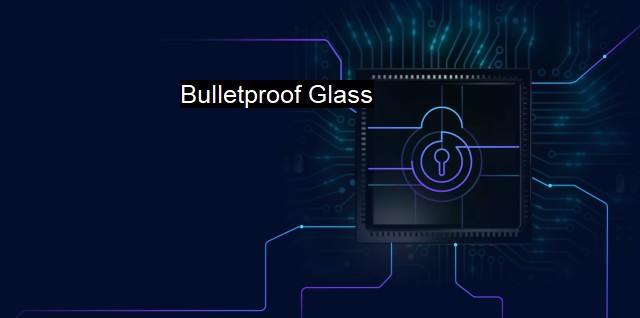What are Bulletproof Glass?
Beyond Physical Structures - How 'Bulletproof Glass' Cybersecurity Reinforces Digital Defense
"Bulletproof Glass" is a term widely used in the fields of cybersecurity and antivirus protection. Despite its origins in the physical security industry - denoting glass engineered to resist high impact damage such as bullets – the concept of bulletproof glass has been metaphorically adopted by cybersecurity experts to explain factors related to the robustness of security measures in digital networks against nefarious cyber-attacks. Therefore, this paper describes the use of the term "Bulletproof Glass" within these dynamic and rapidly evolving fields.Bulletproof glass in the cybersecurity context refers to comprehensive, multi-layered defense systems that are nearly impenetrable by potential digital threats, acting as a robust barrier against cyber attacks that seek unauthorized access, data theft, and malicious disruptions. Its purpose is akin to that of physical bulletproof glass – to protect valuable entities from harmful attacks by providing an exceptional level of security that could withstand even aggressive and persistent attempts at incursion.
Just as bulletproof glass is multi-layered, with each layer contributing to its overall strength and durability, similar principles apply to its cybersecurity counterpart. A bulletproof cybersecurity solution is multi-faceted and applies diverse techniques in unison to provide comprehensive protection. No single technology or methodology is sufficient; robust network security requires an ensemble of firewalls, intrusion detection systems (IDS), and intrusion prevention systems (IPS), complemented by constant monitoring and timely updates.
Antivirus protection, often viewed as a primary line of defense, is a critical component of bulletproof glass in cybersecurity. An effective antivirus solution monitors the system in real time, scanning and analyzing data for potential threats. It can help to identify and exterminate malicious software before they inflict damage, functioning much like the exterior layer of bulletproof glass which takes the initial impact and prevents penetration.
Beyond reactive measures like antivirus software, bulletproof cybersecurity incorporates proactive strategies such as penetration testing and vulnerability assessments, which identify potential weak points and enable security teams to fortify these areas before they are exploited - thus embodying the inner layers of bulletproof glass.
One pivotal attribute of bulletproof glass is its capacity to absorb and dissipate energy, consequently minimizing the impact of bullets. In line with this, bulletproof glass strategies in the digital realm involve the deflection of threats. Through the use of decoy systems or 'honeypots', cybersecurity teams can divert attacks away from critical systems, thereby dissipating the impact and protecting valuable data and infrastructure.
Just as bulletproof glass is custom-made to meet specific requirements and withstand particular threats, cybersecurity measures should be tailored to the organization's needs. Institutions dealing with confidential data or proprietary information may require stronger encryption techniques and stricter access controls, resembling the higher-grade bulletproof glass utilized in high-risk situations.
Much like physical bulletproof glass, no digital defense is completely immune to all potential threats. Even the highest level of bulletproof glass can’t promise complete immunity from bullets- instead, it dramatically reduces such risk. Consequently, maintaining strong cybersecurity requires continuous monitoring, routine enhancements of security protocols, regular staff training and keeping abreast with the latest in technology and cyber threat landscape.
Bulletproof glass as a term and a concept, represents an interpretation of the ideal defense system within cybersecurity and antivirus fields. It encompasses protective measures that are multi-layered, reactive and proactive, continually evolving and tailored to specific needs. it is an ongoing endeavor requiring relentless vigilance and improvement, very much reminiscent of the physical bulletproof glass' purpose - to offer protection and withstand an attack but not to claim invincibility.

Bulletproof Glass FAQs
What is bulletproof glass?
Bulletproof glass, also known as ballistic glass, is a type of glass that is designed to resist penetration from bullets, blasts, and other forms of physical attack. It is made by layering multiple sheets of glass and other materials to create a thick, durable barrier.How is bulletproof glass used in cybersecurity?
In cybersecurity, the term "bulletproof glass" refers to anti-virus and anti-malware software that is highly resistant to attacks. This software is designed to detect and block known and unknown threats, making it difficult for hackers to penetrate a system's defenses.What are the benefits of using bulletproof glass in cybersecurity?
The benefits of using bulletproof glass in cybersecurity include increased protection against cyber attacks, improved system performance, and enhanced peace of mind. With bulletproof glass software, you can feel confident that your system is well-protected against a range of threats.Is bulletproof glass software worth the investment?
While bulletproof glass software can be more expensive than traditional antivirus and anti-malware solutions, it is often worth the investment for businesses and individuals who are serious about protecting their systems from cyber attacks. The added layer of protection and peace of mind can be invaluable in today's increasingly digital world.| | A | | | B | | | C | | | D | | | E | | | F | | | G | | | H | | | I | | | J | | | K | | | L | | | M | |
| | N | | | O | | | P | | | Q | | | R | | | S | | | T | | | U | | | V | | | W | | | X | | | Y | | | Z | |
| | 1 | | | 2 | | | 3 | | | 4 | | | 7 | | | 8 | | |||||||